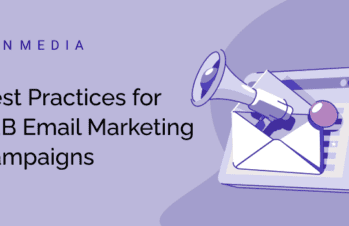Video content may be more popular than ever, but email marketing isn’t going anywhere—in fact, it’s as essential in 2023 as it ever has been.
So how do you take advantage of this highly effective B2B marketing tactic? This guide will show you how to:
- Get started with email marketing
- Build your email list
- Develop an email marketing strategy and send email campaigns
- Measure your email marketing success
- Avoid mistakes that can lead to unsubscribes or sap your ROI
Let’s dive in!
Getting Started with Email Marketing
Before you implement an email marketing program, you’ve got to understand one basic truth:
Email marketing is about your customer—not your brand.
The emails you send out need to be focused on what will give your customers value, be it industry information, free trials, or learning opportunities. The point of B2B email marketing is relationship building—not obtaining a quick, one-time conversion.
If you focus on building the relationship, the conversions will come.
Reasons to Use Email Marketing
Email marketing is something that every marketer should have in their toolbox. Just consider that, according to HubSpot, email generates $36 for every $1 spent.
Not to mention the fact that email marketing still drives more conversions than any other marketing channel—including social and search.
Email marketing can be used for many reasons and to achieve many different goals, including:
- Boosting brand awareness
- Promoting a new product or service
- Sharing content
- Lead generation
- Moving leads through the sales funnel
- Increasing conversions for a specific product or action
Your emails will look different depending on the goal and audience you’ve set for each campaign.
How to Build Your Email List
How do you get your customers’ and prospects’ emails in the first place?
There are a few different ways to do this.
One way is to buy an email list—however, this is NOT recommended as it’s almost certain to backfire. If prospects start getting emails they never signed up for, you’ll not only find yourself with a whole lot of unsubscribes, but you’ll also potentially damage your brand reputation.
The better way is to set up an opt-in program that offers your customers value in exchange for their email addresses and/or other personal information. Here are a few options.
Create a Lead Magnet
A lead magnet is a piece of content that will attract leads (hence the term). It’s something that is valuable enough for prospects to feel comfortable offering their email address or other information.
How do you create an irresistible lead magnet?
First, study your audience carefully. Consider your personas. Get to know your community.
What are their biggest concerns? What are their pain points? What makes them feel successful? Take those answers and create a simple one-page tool, resource, or cheat sheet that solves their problem. That is your lead magnet.
To be most effective, use your lead magnet to pre-qualify your opt-ins. Make it on a subject or action related to your service or industry.
Successful lead magnets are fast to make (it should cost you little to publish) and easy to use (it makes the consumer feel successful or more knowledgeable immediately). And the better and more tuned-in to your customer’s needs, the more likely your customer will share it, thereby growing your community.
Once you’ve created your lead magnet, create a simple landing page. This is where your audience will opt-in to your email list and obtain your lead magnet.
As the page you use to grow your email list, this is one of the most important pages you’ll create on your website. Make it clean with clear, simple text describing what you are offering and why they need it.
Eliminate any other distractions to your reader—there should be no sidebars, advertisements, or secondary calls to action. You want the bold button to compel the reader to subscribe now.
Next, you’ve got to promote your lead magnet.
- Put a graphic on your website’s sidebar.
- Talk about it on social media.
- Advertise it on Facebook and Google AdWords.
- Mention it at the bottom of blog posts.
If you do this consistently, and your lead magnet is meeting your prospects’ needs, you’ll soon see your list begin to grow.
Include an Email Sign-Up Button or Form on Your Website
In addition to the lead magnet, you’ll need a simple form or block on your website where customers can sign up for your marketing emails or newsletter if you have one.
Newsletters can be a great way to build an ongoing relationship with your customers, however, you’ve got to be sure that you have the time, resources, and content needed to deliver something valuable on a regular basis (weekly or monthly).
If you’re not there yet, it’s best to simply send marketing emails around different topics, offers, or content as you have them.
Developing an Email Marketing Strategy and Sending Marketing Emails
Now that you’re growing your list, it is time to create your email marketing strategy.
While the occasional pure promotion is acceptable, the majority of your emails should provide valuable information to your audience.
Regular requests to “buy now” are tedious and lead to your emails either ending up in the spam folder or lots of unsubscribes.
To avoid this, offer regular tips, compelling content, and special offers just for subscribers. This ensures your emails stay valuable to your audience.
Segment Your Lists
Segmenting your lists lets you target specific audiences with different email campaigns.
One of the simplest ways to do so is to segment prospects, first-time customers, and long-term customers.
You can also segment by interest or industry if you offer products and services geared toward different customers.
For example, you may want to target your e-commerce customers with one email campaign and your agency customers with a different one.
Similarly, you may have email campaigns targeting CMOs and another targeting CFOs.
Once you’ve segmented your list, start brainstorming email campaigns based on one clear goal: boosting awareness, encouraging people to buy a product, generating interest in your content, etc.
Create Your Emails
First, consider your email subject line. Is it bold, compelling, and unique? Use the word “you” to personalize the message at first glance. Make the subject line so closely tied to your audience’s concerns and goals that they can’t help but open your email to read more.
Inside the email, design the message around one clear call to action. What do you want the reader to do with this email?
Possible actions could be:
- Share the email content with a friend
- Post the email article on social media
- Download a free report
- Purchase a product
Make sure you are clear on your desired outcome, then go from there.
Keep Your Email Simple
The honest truth is most people aren’t going to read your entire email. That’s why you should design your email to make the important things stand out.
Use a bold image, large headings, and simple sentences to quickly communicate your message. Don’t bog the reader down with a lot of text—keep it short and simple.
Above all, create a consistent tone for your email campaign. When your readers see your email address in their inbox, do they immediately know what to expect? By strategizing carefully around your email marketing campaigns and construction, you build a relationship of trust with your readers. Later, when you call on your audience to purchase, they will be ready to take you at your word.
How to Measure Your Email Marketing’s Effectiveness
One of the most important aspects of email marketing is ongoing analysis. Thanks to the many email platforms out there, these analytics are easily available and easy to use. In addition, make sure to follow some phishing statistics so that your emails are safe, and your recipients have the best experience
Overall, the four key KPIs you should focus on are:
- Click-through rate: the percentage of readers who are clicking your calls to action
- Open rate: the percentage of recipients who are opening your emails
- Deliverability: the percentage of recipients who are actually receiving your emails (in other words, how many “undeliverable” emails you’re sending out)
- Unsubscribe rate: the percentage of readers who are unsubscribing from your emails
You can view each of these based on individual emails or groupings over time. You can also try to increase email deliverability by implementing an SPF checker and taking necessary email security measures.
Of course, to know how you’re doing, it helps to have some benchmarks. These are overall email marketing averages for different actions as reported by Campaign Monitor:
- Average open rate: 18.0%
- Average click-through rate: 2.6%
- Average click-to-open rate: 14.1%
- Average unsubscribe rate: 0.1%
If your rates are lower (or higher (depending on which KPI you’re looking at), then it’s probably time to start split-testing your emails.
How to split-test email campaigns
Split-testing means you send a different version of one email to two segments of the same audience to see which performs better.
To do this effectively, you must test only one email element at a time. For example, you could create two different subject lines and see which email has a higher open rate. Or you could create two different calls to action and see which promotes a higher click-through rate.
This is something you can do periodically to continue improving your email marketing program over time.
Email Marketing Mistakes to Avoid in 2023
Even the best email marketing campaigns can be derailed by a simple mistake. Here are some of the most common to avoid.
- Forgetting to welcome subscribers: After going through the trouble of finding your site and signing up to get emails from your brand, it’s just polite to send a thank you, but it’s also good business. Purpose-driven welcome emails “generate 4x more opens and 5x more clicks,” according to Dispatch.
- Sending too many emails: According to Campaign Monitor, 121 business emails are sent and received daily. That’s a lot of traffic to disrupt. And in this case, less can be more. Avoid annoying your customers by strategically delivering your promotions on a healthy timeline (say, once a week).
- Failing to include a call to action: Hopefully, most marketers understand that including a CTA is the bedrock of a successful email marketing campaign. But even more importantly, keep that CTA clear and concise so that a subscriber has no trouble understanding the message. If your message is difficult to understand, it’s likely to be deleted.
- Using too many CTAs: This can confuse your customers, causing them not to act at all. Ensure each email has one primary directive, so customers know what action you’re asking them to take.
- Using poor design: Keep things streamlined. Avoid inconsistent fonts, low-resolution images, broken links, or too many images in one email. A visually appealing email represents your brand and makes customers want to interact with you.
- Not segmenting subscribers: No two subscribers are alike. Use the data you’ve collected to segment your audience by job title, location, purchase history, and more.
- Not optimizing for mobile: Nearly half of all searches happen on mobile, so if your emails don’t open properly on a phone, you’ll probably lose subscribers. Make sure to test, edit, and test again to ensure your campaign is optimized for mobile.
- Failing to proofread: People don’t like sloppy copy. Make sure you have multiple points of review before each email is sent out to check for errors and misspellings.
Want more information on mistakes to avoid? Read 9 B2B Email Marketing Mistakes to Avoid in 2023. If you’re ready to get started with your B2B email marketing or just need a little boost, our team of experts is ready to help.




